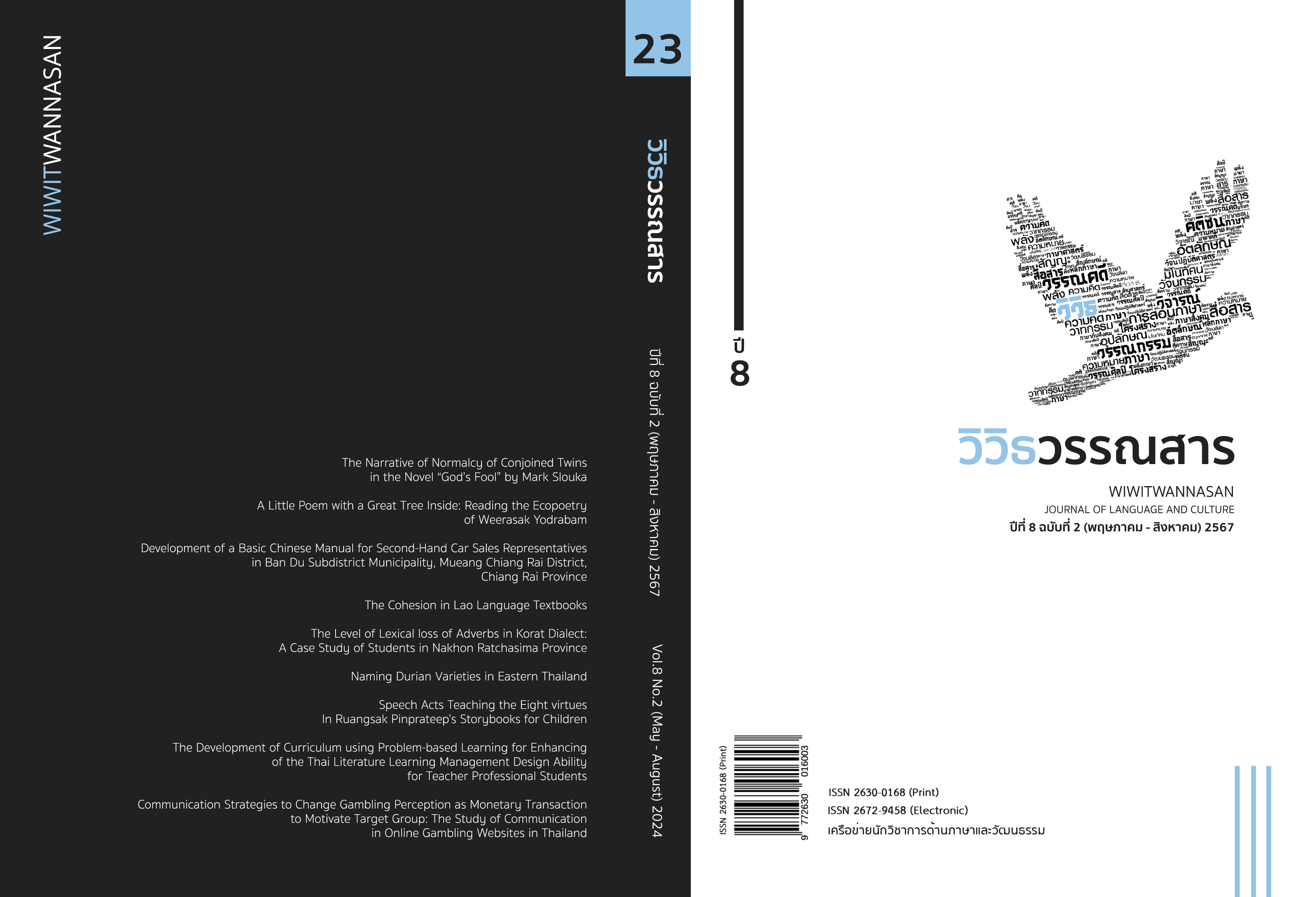เรื่องเล่าของความปกติของแฝดติดกันในนวนิยายเรื่อง “ก๊อดส์ ฟูลล์” ของ มาร์ก สโลคา
Main Article Content
บทคัดย่อ
งานวิจัยเรื่องนี้มีจุดประสงค์เพื่อวิเคราะห์ความพยายามที่จะสร้างความปกติของแฝดติดกันผ่านเรื่องเล่าของจัน บังเคอร์ ในนวนิยายเรื่อง “ก๊อดส์ ฟูลล์” (2003) ของมาร์ก สโลคา และเพื่อวิพากษ์วาทกรรมทางการแพทย์ที่สร้างภาพเหมารวมเชิงลบของแฝดติดกันในประเด็นเรื่องของการดำรงชีวิตและความสัมพันธ์ทางเพศ โดยกลวิธีที่ผู้ประพันธ์ใช้สร้างความปกติให้กับจันคือการนำเสนอภาพความสัมพันธ์ระหว่างพี่น้องฝาแฝดและความสัมพันธ์ทางเพศกับเพศตรงข้ามให้มีลักษณะที่แตกต่างไปจากที่ปรากฏในงานวรรณกรรมต่างๆ กล่าวคือ มิได้เขียนอธิบายความสัมพันธ์ระหว่างพี่น้องในเชิงของการถูกกักขัง ถูกจำกัดอิสระภาพอันเนื่องมาจากสภาพร่างกายที่ติดกัน ทำให้แฝดคนใดคนหนึ่งหมกมุ่นอยู่กับความปรารถนาที่จะแยกร่างออกจากกัน แต่นำเสนอในเชิงความสัมพันธ์ฉันพี่น้องที่สนิทสนมกัน รวมทั้งแสดงให้เห็นอัตลักษณ์เชิงบวกของแฝดติดกัน ในประเด็นเรื่องทางเพศ เมื่อวิเคราะห์ผ่านทางความสัมพันธ์ของอินและจันและภรรยาของพวกเขา ผู้ประพันธ์มิได้เล่าเรื่องโดยมุ่งประเด็นไปที่ความสัมพันธ์ทางเพศที่มักจะจินตนาการว่าต้องเป็นเรื่องที่ผิดทำนองคลองธรรม รวมทั้งการนำเสนอให้เห็นถึงความสัมพันธ์ของสามีภรรยา และคนในครอบครัวซึ่งมิได้แตกต่างไปจากคนทั่วไป ทำให้เห็นว่าสภาพร่างกายของแฝดติดกันมิได้เป็นอุปสรรคหรือเป็นสาเหตุที่ทำให้พวกเขาไม่สามารถใช้ชีวิตอย่างคนทั่วไปได้ ดังนั้น การนำเสนอภาพของแฝดติดกันในนวนิยายเรื่องดังกล่าวแสดงให้เห็นถึงความพยายามที่จะสร้าง “ความเป็นปกติ” ของแฝดติดกัน รวมทั้งวิพากษ์วาทกรรมทางการแพทย์เกี่ยวกับประเด็นเรื่องการผ่าตัดแยกร่างกาย การล้มล้างทัศนคติ ความเชื่อ และความเข้าใจแบบเหมารวมเกี่ยวกับแฝดติดกัน
Article Details

อนุญาตภายใต้เงื่อนไข Creative Commons Attribution-NonCommercial-NoDerivatives 4.0 International License.
ลิขสิทธิ์ของบทความเป็นของวารสาร การพิมพ์ซ้ำจะต้องได้ร้บการอนุญาตจากบรรณาธิการวารสาร
เอกสารอ้างอิง
An Historical Account of the Siamese Twin Brothers from Actual Observations. (1834).
New York: J.M. Elliot, 1834. Retrieved from http://hdl.handle.net/11134/110002:2477
Angier, N. (1997, December 23). Joined for Life, and Living Life to the Full. New York
Times. Retrieved from https://www.nytimes.com/1997/12/23/science/joined-for-life-and-living-life-to-the-full.html
Browning, T. (Director). (1932). Freak. [Film]. Metro-Goldwyn-Mayer.
Davies, H. (2015). Seperation Anxieties: Sex, Death and Chang and Eng Bunker. Neo-
Victorian Freakery: The Cultural Afterlife of the Victorian Freak show (pp.61-91). Houndmills, Basingstoke: Palgrave Macmillan
Davis, L. J. (1995). Constructing Normalcy. Enforcing Normalcy: Disability, Deafness, and the Body. London: Verso.
DeRuiter, C. (2011, November 03). Conjoined Twins. Embryo Project Encyclopedia. Retrieved from https://embryo.asu.edu/pages/conjoined-twins
Dreger, A. D. (2004). One of us: Conjoined Twins and the Future of the Normal. Massachusetts: Harvard University Press.
Dunn, K. (2002). Geek Love. New York: Vintage Contemporaries.
Fiedler, L. (1978). Freaks: Myths and Image of the Secret Self. New York: Simon and Schuster.From ‘Monsters’ to Modern Medical Miracles: Selected Moments in the History of Conjoined
Twins from Medieval to Modern Times. (2014) U.S. National Library of Medicine. Retrieved from www.nlm.nih.gov/hmd/conjoined/age.html
Farrelly, P. & Farrelly, B. (Director). (2003). Stuck on You. [Film]. 20th Century Fox.
Hilton, D & Hilton, V. (1950). Intimate Loves and Lives of the Hilton Sisters. Wonder Book: California. Retrieved from https://archive.org/details/lives_hilton_sisters
Jensen, D. (2006). The Lives and Loves of Daisy and Violet Hilton: A True Story of Conjoined Twins. Ten Speed Press.
Johnson, D. (2001). An Introduction to Disability Studies (2nd ed). London: David Fulton Publishers.
Kennedy, G.E. (2011). The 3,000-Year History of Conjoined Twins. West J Med, 175 (3), 176-177. Retrieved from www.ncbi.nlm.nih.gov/pmc/articles/PMC1071535/
Kompanje, E. (2004). The First Successful Separation of Conjoined Twins in 1689: Some Additions and Corrections. Twin Research,7 (6), 537-541. Retrieved frompdfs.semanticscholar.org/5869/1ba7140350245419b3fbc2a6e0ee63db67c8.pdf
Quigley, C. (2003). Conjoined Twins: An Historical, Biological and Ethical Issues Encyclopedia. London: McFarland & Company
Siebers, T. (2012). 1 A Sexual Culture for Disabled People. In R. McRuer & A. Mollow (Ed.), Sex and Disability (pp. 37-53). New York: Duke University Press.
Shakespeare, T. (2000). Disabled Sexuality: Toward Rights and Recognition. Sexuality and Disability, 18, (3), 159-166. Retrieved from https://cr.middlebury.edu/amlit_civ/allen/field_house/2012%20backup/scholarship/shakespeare_essay2000.pdf
Slouka, M. (2003). God’s Fool. USA: Knopf.
The Case of Conjoined Twins in 10th Century Byzantium. (2014). Medievalist.net. Retrieved from http://www.medievalists.net/2014/01/the-case-of-conjoined-twins-in-10th-century-byzantium/
Wallace, A. (2011). THE TWO: A Biography of the Original Siamese Twins. Crossroad Press.


